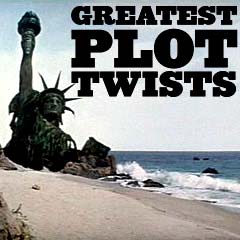
|
|
|
||||||||||||||
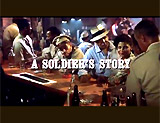
|
A Soldier's Story (1984)
Norman Jewison's murder mystery was set during the WWII era (1944), in a time of segregationist Jim Crow laws in the South, and an atmosphere of racism and bitterness. The locale was Fort Neal in Louisiana - a segregated Southern military base for black platoons. The tagline described the plot's main outline:
The precipitating event was the murder (with a .45 caliber pistol) of a bitterly-resented officer of Company B:
His last words were: "They still hate you. They still hate you." The investigation (told through flashbacks) was conducted by:
It was at first thought that the drunken Waters was killed by white officers or the Ku Klux Klan. However, there were doubts raised because Waters' uniform stripes and insignia hadn't been ripped off - a typical indication. Davenport faced many obstacles in his investigation: deceit, prejudice, lack of cooperation, a resistant chain of command, and black troops who were afraid to talk. Many of those questioned, including a number of fellow soldiers (black and white), had a motive to kill Waters. There were also conflicting accounts about Waters' nature - was he tyrannical, or good-natured? During the case, one pivotal character emerged:
Waters had derogatory feelings toward C.J. - he called him "Geechee" - and admitted that he had already jailed five previous "Geechee" recruits like C.J. To set up the despised C.J., Waters tricked him, provoked him, caused him to strike back, then charged him with hitting a superior officer, and jailed him. Sergeant Waters described his racist feelings toward inferior blacks like C.J. - he spoke directly to the unjustly incarcerated C.J. behind bars:
Shortly later, C.J. was driven to commit suicide - he was found hanging from his jail cell bars. In the conclusion, it was revealed that Waters had been killed by unrepentant, resentful and militant Pvt. First Class Peterson (Denzel Washington) who explained that the murder was revenge for driving C.J. to kill himself. Peterson confessed to Davenport:
|
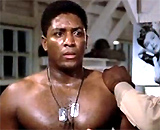 "Geechee" C. J. Memphis (Larry Riley) 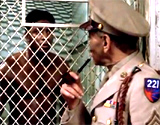 C.J. Jailed by Waters 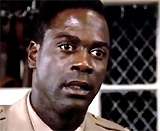 Capt. Davenport (Howard E. Rollins)  Drunken Sgt. Waters (Adolph Caesar) The Night of His Murder 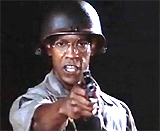 The Murderer: Pvt. First Class Peterson (Denzel Washington) 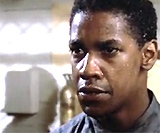 Peterson's Confession to Davenport |
||||||||||||

|
Although this classic comedy lacked a typical surprise ending or ingenious plot twist, it still ended with a great closing scene that contained the greatest fade-out line in film history. The two couples took off in a getaway boat:
In the film's classic closing scene, Joe literally removed his blonde wig and feminine clothing to reveal his true identity. The vulnerable Sugar knew of the hoax and his deceitfulness as a fake millionaire, but vowed to love the "no-goodnik" anyway. Next, rich suitor Osgood Fielding III resumed his persistently-amorous attention toward Daphne/Jerry, and proposed marriage. Jerry attempted to end his relationship with Osgood, breaking the news gently to him by discouraging his affection. There are many limitations, Daphne/Jerry argued, including her physical shape, her hair color, her smoking habit, the fact that 'she' had sinfully "been living with a saxophone player", and the problem of infertility. Finally in exasperation after she/he was unsuccessful and failed miserably, Daphne/Jerry gave up trying to break the news gently to him to discourage his unflappable affection. He finally revealed the obvious mismatched gender problem:
|
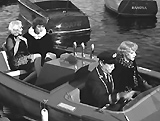 The Getaway Boat 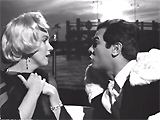 Joe (Tony Curtis) and Sugar (Marilyn Monroe) 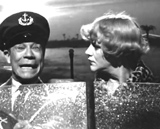 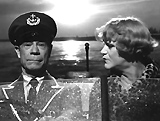 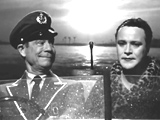 Osgood (Joe E. Brown) and Daphne/Jerry (Jack Lemmon) |
||||||||||||

|
Sophie's Choice (1982)
In this post war-time drama set in 1947 by writer/director Alan J. Pakula with multiple flashbacks, Polish-Catholic refugee/immigrant Zofia "Sophie" Zawistowski (Oscar-winning Meryl Streep) had relocated and was living in Brooklyn, NY with frequently-drunk, mentally unstable lover Nathan Landau (Kevin Kline), who falsely claimed to be a research chemist. In the same dingy boarding house was aspiring Southern writer-author Stingo (Peter MacNichol). He learned about his flamboyant upstairs neighbors, one of whom he discovered was a haunted, Nazi prison camp survivor. Holocaust-obsessed, Jewish Nathan had 'saved' Sophie after she had been liberated. In her past, she had suffered tragedy in the Auschwitz concentration camp where she was interned and imprisoned. She had to make a difficult and horrible choice between her two children - which of them would be executed. In the heartbreaking scene, she begged not to choose, but was forced to make a decision - to send her daughter Eva (Jennifer Lawn) to a crematorium ("Take my little girl"), while her son Jan (Adrian Kalkika) would go to a child labor camp (she never found out about his fate). In the film's downbeat ending, the self-loathing Sophie made love with Stingo, but then left his bed with a hand-written suicide note for him on the pillow. Tormented and guilt-ridden by her memories, she returned to Nathan, and with him suicidally took sodium cyanide. |
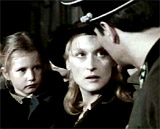 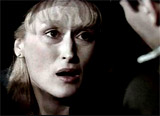 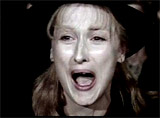 During the Holocaust - Sophie: "Take my little girl" 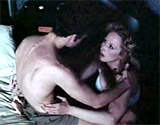 Sophie With Stingo (Peter MacNichol) 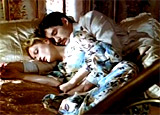
Suicide With Nathan Landau (Kevin Kline) |
||||||||||||

|
Soul Survivors (2001)
This poorly-executed, bland PG-13 psychological thriller, a stereotypical teen horror film from writer/director Steve Carpenter. [After its theatrical release as a PG-13 film, the DVD release was dubbed "The Killer Cut" with additional flashes of nudity, gore and obscenities.] It gave away its basic plot twist in its tagline:
It was an ordinary film with the cliched plot twist found in Jacob's Ladder (1990), The Sixth Sense (1999), and The Others (2001). There were two killers in the film's prologue (so to speak), both of whom would continue to appear later in the film.
The duo assaulted sorority girl Kathy/Cathie? (Carrie Southworth in an uncredited role as Murdered Girl) (Cassie's alter-ego?) on 'fraternity row', slit her wrist, and drained her life's blood. Next, the film's deadly accident was the main turning point - it included most of the major characters, who were occupants in a van after a night of partying:
The viewer was led to believe that everyone survived except Cassie and her boyfriend Sean, who had pledged his love to the reluctant Cassie just before the crash. Without even watching the film, one could speculate that the 'soul survivors' of the film's title were the only two survivors of a deadly car accident that occurred early in the film, and the main protagonist Cassie was struggling to live afterwards. The film wanted you to believe that she survived, but was experiencing strange and ambiguous happenings in her daily student life while hovering between 'the world of the dead and living.' The surprise ending, although predictable, was un-climactic and trite. After recovering, Cassie was accompanied by Matt, Annabel and Raven (now lesbian lovers), who all seemed to have turned dark, goth and ghoulish. Sean also fleetingly appeared to her, telling her:
She was also counseled by the spirit of a kindly Priest named Jude (Luke Wilson) who had died in 1981, years earlier. Cassie was haunted by guilt, because she didn't reciprocate her love for her boyfriend Sean just before the crash. As the film ended, flashbacks to the crash scene revealed that Sean and Cassie were the only survivors, but Cassie was in a coma in the hospital and struggling to come back after suffering serious head trauma. The entire film was composed of her out-of-body hallucinations, delusions, thoughts, and fears in a supernatural realm. She had misrepresented reality in her unconscious dreams. She fought off death while in these dreams, as Jude explained:
She claimed she loved Sean and asserted she wanted to come back for him: "I don't want to die...I would die for him...I don't want to die." She called out for him, and apologized: "I never told you...I-I love you" before they kissed, and she revived and came back to life. In the final scene, she woke up from another disturbing dream, but she was alive, next to Sean in bed. She nodded when he asked: "That dream again?" |
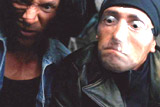 The Two Killers in Prologue 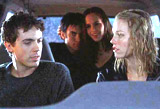 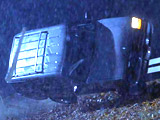 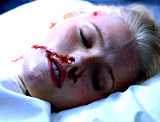 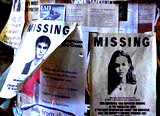 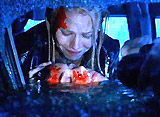 The Van and Accident   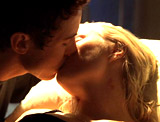 Cassie Brought Back by Her Boyfriend Sean |
||||||||||||

|
Source Code (2011)
Director Duncan Jones' sci-fi thriller had hints of Groundhog Day (1993), Retroactive (1997), and Run, Lola, Run (1998). Its tagline was:
It opened with 17th Airborne helicopter pilot/soldier Capt. Colter Stevens (Jake Gyllenhaal) on a Chicago-bound commuter rail train, a few stops from downtown. He was disoriented as to who he was, why he was on the train, and the identity of the pretty unknown woman seated across from him, dark-haired 28 year-old Christina Warren (Michelle Monaghan) - and in just eight minutes time, the train and all of its approximately 100 occupants were obliterated by a massive explosion. Just before the explosion, she assured him: "Everything's gonna be okay." After the explosion, he found himself enclosed in a small, dark geodesic-shaped, metal space capsule (part of his neural environment). He was in contact with a control center, code-named Beleaguered Castle, located at the Nellis Air Force military base near Las Vegas, Nevada. He was communicating and monitored via a video screen, with a uniformed female handler - divorced Air Force Capt. Colleen Goodwin (Vera Farmiga). Stevens had been paired up or implanted with the memories of one of the blast victims compatible with him - history teacher Sean Fentress. He was linked up to Fentress' avatar in the last eight minutes of his life, the length of a "short-term memory track" in the brain after death, that also provided a temporary 8-minute window into the parallel universe. Although unwilling, Stevens (as Fentress) was tasked with the mission to continually be resent into the Source Code to go back to the scene of the explosion, to determine the identity of the terrorist bomber on the train - to save lives and prevent a second city-wide radioactive blast of a "dirty bomb" that threatened the entire Chicago population.
The female officer's duty was to orient him after each devastating blast (with tricks similar to the triggering device in The Manchurian Candidate (1962)), with a story containing code words, a sequence of playing cards, and a recording of a Western screech owl, followed by an exercise in pattern recall. He kept asking questions about his unit and crew, when he could call his father, and whether he had been evacuated or not, but wasn't given answers. Goodwin was supervised by Dr. Strangelove-esque superior Dr. Rutledge (Jeffrey Wright).
Goodwin explained the nature of the mission: "The program wasn't designed to alter the past. It was designed to affect the future" - meaning that Stevens could save future lives only, not the lives of the passengers on the ill-fated train. Stevens asked Rutledge and Goodwin to terminate his service (and life support) and let him die once and for all ("There will be no coming back"). They promised that they would comply with his wishes once his mission was accomplished and he identified the bomber. During each recreated, frustrating short trip on the train, played numerous times (each with crucial variations and sometimes deadly consequences), Goodwin (as Fentress) was instructed to learn about the various passengers ("Get to know them. Narrow the suspect pool. Look for ones who seem quiet or withdrawn. Who seem nervous"). He pursued and questioned a sickly Middle-Eastern looking man, stand-up comedian Max Denoff, a bearded software engineer with a backpack, an older woman with the tote bag from Walter Reed Military Hospital, a man who had deliberately dropped his wallet (the terrorist himself), and more. By the end of the film, he had solved the mystery, reported disgruntled terrorist Derek Frost's (Michael Arden) rented white van license (with the dirty bomb inside), and a SWAT team had arrested the terrorist. However, the train's explosion still hadn't been averted. Stevens asked Goodwin for one final opportunity to alter events - although discouraged and told it was impossible - to avert the train disaster and save the passengers, including Christina - and then die peacefully:
Granted the opportunity, he located the bomb planted above a vent in the train's bathroom, with two cell-phone detonators. Against all odds, Stevens was able to successfully thwart the train bombing, disarm and handcuff Derek Frost, send a cell-phone description of the terrorist, and report the location of the van carrying the bomb. Then, Colter Stevens (posing as Sean Fentress) phoned his estranged father Donald Stevens (voice of Scott Bakula), who was still grieving Colter's death in the war. He was able to reconcile himself with his father - and resolve long-standing issues:
Then, going back on his word, Rutledge ordered Stevens' memory to be erased and reinitialize Source Code - so he could be reused for future missions. In the final few seconds of the last eight-minute time frame aboard the train, Stevens and Christina kissed. The frame froze - at the same moment that Goodwin was about to turn off Stevens' life support. To his surprise, he came to life again (in a "parallel reality") in an alternate universe ("a whole new world") within Sean Fentress' body - he was saved along with everyone else. He was enjoying a perfectly beautiful day in downtown Chicago with Christina. To prove that it was possible to alter reality, he had sent Capt. Goodwin an email (with some of the code-words from the familiar story he had heard earlier) that ended the film - about how Source Code had succeeded in providing him with new life, as the train attack was thwarted and the terrorist was caught. Goodwin's email was read (in voice-over with Stevens' voice), as the film ended. He was awaiting assignment to a new "mission" from his alternate universe:
|
 Capt. Colter Stevens (Jake Gyllenhaal) 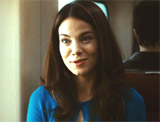 Christina Warren (Michelle Monaghan) 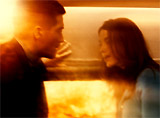 Train Explosion 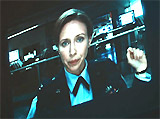 Air Force Capt. Colleen Goodwin (Vera Farmiga)  Stevens Apprehending Terrorist Bomber Derek Frost at His Van  The Dirty Bomb in the Van  Stevens Phoning His Father, As Sean Fentress 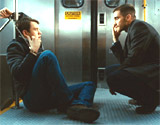 The Last Successful Trip Into Train  The Kiss 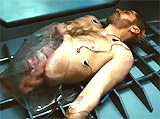 Stevens' Comatose Mutilated Body Hooked Up to Sensors - On Life Support 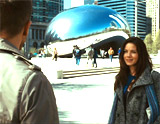 Day in Chicago 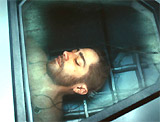 Stevens, Still Comatose, But in a Parallel Reality - Ready for a "New Mission" |
||||||||||||
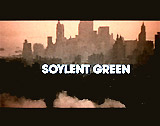
|
Soylent Green (1973)
This early cautionary 70s science-fiction film by Richard Fleischer, set in an overpopulated, impoverished and polluted world of 2022, contained a surprise ending, although it has since become common knowledge that the film contained a twist regarding its title "Soylent Green" due to the film's trailer asking:
In the revealing trailer, two conveyor belts were shown, one with body bags, the other with green food. The title referred to a type of artificial or processed food substance rationed out to the lower and middle-class populace in the crowded metropolitan areas. The film's lengthy tagline teased about the movie title:
New York City Detective Thorn (Charlton Heston) had been assigned to investigate the murder of a wealthy businessman, William R. Simonson (Joseph Cotten), an influential board member of the financially-profitable Soylent Corporation that was manufacturing healthy, high-energy green wafers from ocean plankton. In the film's conclusion, Detective Thorn was near the death bed of Sol Roth (Edward G. Robinson in his final film role) in an assisted-suicide facility known as the "Home" (within Madison Square Garden). He had chosen a poignant, painless and suicidal death in one of the euthanasia clinic's private chambers. He was put to rest (to "go home") with orange-hued lighting, classical music playing (Tchaikovsky's "Pathetique" Symphony No. 6, Beethoven's "Pastoral" Symphony No. 6, and segments of Grieg's "Peer Gynt Suite") and projected video (of a peaceful and "beautiful" green Earth ages ago when animal and plant life thrived and there was no pollution).
Sol died amidst the musical and visual montages with his tearful friend Thorn near him in a sealed control room. Before dying, Sol told Thorn: "I've lived too long." Thorn replied: "I love you, Sol." Thorn was astounded by the images: "How could I know? How could I, how could I ever imagine?" Then Sol revealed what he had learned about Soylent Green and its major secret, after choosing assisted suicide with a lethal drug:
Within a waste-disposal center or plant, Thorn then proved the horrifying, predictable discovery of the true composition of the Soylent Corporation's new artificial food product Soylent Green - it was not composed of ocean plankton - ruled an impossibility by The Exchange (a group of researchers) due to barren ocean conditions. Instead, it was composed of the recycled bodies of the deceased inhabitants of the society's euthanasia centers.
Thorn made a desperate plea to his lieutenant partner, police chief Hatcher (Brock Peters) as he was dragged away to be treated for a serious gunshot injury:
|
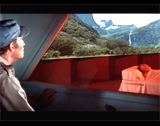 Thorn (Charlton Heston) in an Adjacent Viewing Room To Witness Sol's Euthanasia 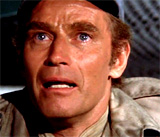 Thorn Shedding Tears Over the Gorgeous Beauty of a Past Earth, and Sol's Passing 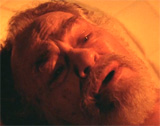 Sol's (Edward G. Robinson) Last Dying Words to Thorn: "Please, Thorn. Prove it, Thorn. The Exchange" 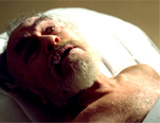 Sol's Actual Death - The Orange Light Was Extinguished 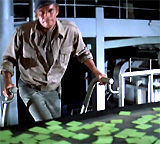  Conveyor Belt of Green Food
|
||||||||||||

|
The Spanish Prisoner (1997)
Writer-director David Mamet's suspenseful dramatic thriller was based on the age-old confidence trick (or con), similar to the Nigerian email scam, in which a gullible mark was convinced to turn over something valuable (usually money). In the "Spanish Prisoner" trick (described by a fake FBI agent in the film as the "oldest con in the world" that plays on "vanity and greed"), the duped individual was convinced to help release an unidentified imprisoned wealthy Spanish individual, to later be rewarded (by the prisoner's fortune and girl). In the intriguing film set in March of 1997, naive corporate engineer Joe Ross (Campbell Scott) had developed (or invented), with co-developer and lawyer George Lang (Ricky Jay), a top-secret, unpatented program (or formula) created during a work-for-hire contract. It was dubbed "The Process," and was supposedly a proprietary means for businesses to become extremely lucrative ("to control the global market"). Select company members traveled to a corporate retreat at the Caribbean island resort of St. Estephe, popular with Japanese tourists. [Early in the film, Joe was told that security videotapes of the dock area were kept for insurance purposes.] Joe spoke about the formula (only one copy existed) to corporate executives including Joe's own boss, Mr. Klein (Ben Gazzara), who kept putting him off about special bonus compensation. Joe boasted that his invention was designed to put their company 3-5 years ahead of others, and make lots of money. Ross quickly became acquainted with various individuals during the Caribbean island business trip:
As Joe was about to return to NY, Jimmy asked him to deliver a small package to his "young and pretty" sister Mrs. Emma DaSilva at the Wiltshire. She was reported to be an Olympic-class tennis player. Joe opened the brown-paper wrapped package - it was a 1939 book titled "Budge on Tennis." Jimmy continually encouraged Joe to socially meet his sister once they both returned to NY, claiming that Joe was "a good fellow" - but various misunderstandings and issues always prevented it. Susan quipped tell-tale lines to Joe on the returning plane about trust: "Shows to go you, you never know who anybody is...Who in this world is what they seem." And Jimmy advised Joe about not trusting his boss Klein:
To protect his interests, Jimmy urged Joe to meet with his own recommended non-company lawyer, and asked Joe to bring his sole copy of "The Process" to a 10 am meeting with the lawyer at the carousel in the park. Joe began to suspect that Jimmy was a con artist (and wanted to steal his work), so he arranged to meet with FBI Agent Pat McCune to set up a sting-operation, and Joe was wired for the meeting. Revelations in the film began to come out, and the various deceptions of the con game were unwound. Joe was the one who was being swindled as the mark (an innocent victim). Joe was made to look suspicious, for selling his "Process" for a huge sum of money before fleeing to Venezuela:
|
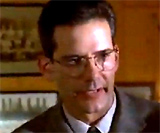 Joe Ross (Campbell Scott) 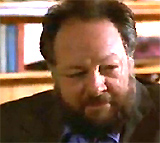 George Lang (Ricky Jay)  Susan Ricci (Rebecca Pidgeon) 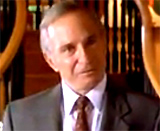 Mr. Klein (Ben Gazzara)  Pat McCune (Felicity Huffman) 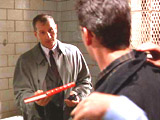 "The Process" Red Binder 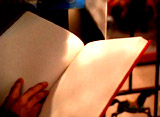 The Red Binder With Blank Pages 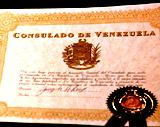 Signed Certificate - To Flee to Venezuela  Airplane Ticket to Venezuela 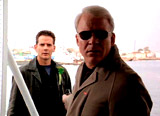 Julian "Jimmy" W. Dell (Steve Martin) 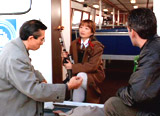 The Ferry 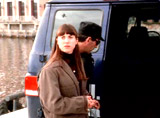 Jimmy and Susan Arrested and Taken Away  Joe Ross (Campbell Scott) Left on Dock |
||||||||||||
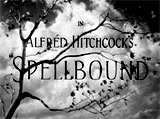
|
Spellbound (1945)
In the conclusion of Alfred Hitchcock's superb mystery thriller set in a psychiatric institution, there was a shocking confrontational scene that led to a surprise suicide death. At a Vermont mental hospital-asylum (Green Manors), a new handsome psychiatrist named Dr. Anthony Edwardes (Gregory Peck) had arrived to replace the outgoing director or head of the institution, Dr. Murchison (Leo G. Carroll). At the same time, Murchison was mentoring intellectual, cool-minded Dr. Constance Petersen (Ingrid Bergman), another psychoanalyst. Dr. Petersen engaged in a love affair with the handsome new director of Green Manors, Dr. Edwardes. As their love deepened, she began to become concerned about Edwardes' mental state. He suffered from paranoia, neurosis and memory loss (amnesia), frequently saw disturbing images, including recurring lines on a white background, parallel fork lines on a tablecloth, and sled tracks and patterns on a bedspread. She also began to rationally suspect that Dr. Edwardes was delusional and homicidal, and had murdered the real Dr. Edwardes. As a result of Dr. Petersen's probing, Edwardes admitted that he was an imposter, and expressed fears that he may have killed the real Dr. Edwardes, and then taken his place. He fled from the institution, with Dr. Petersen in pursuit. She encouraged him to use psychoanalysis to discover what really happened. Imposter Edwardes took the name 'John Brown' - and would soon remember that his name was really Dr. John Ballyntine (or "JB") (also Gregory Peck). During dream analysis, Ballyntine described playing blackjack (21) at a casino (with eyes on the walls) with a seven of clubs, a bearded man and a faceless proprietor, including images of a sloping roof, a man with a misshapen wheel, and pursuit by a giant pair of wings - (the sloping roof was tied to JB's memory of his brother's accidental and tragic death by impalement on a spiked fence, when he slid down the roof and accidentally knocked his brother off - killing him on the spiked railing). In the film's plot twist, the parallel lines in the imposter's dreams represented his partial, corrupted memories of a traumatic ski accident at Gabriel Valley that he had witnessed. (He had actually witnessed the murder of the real Dr. Edwardes, his analyst, on the ski slope, but repressed it. Ballyntine inaccurately recalled watching his ski partner fall off a steep precipice and die during a skiing vacation. However, in reality, he was able to stop both of them just in time before plunging over the edge.) When the police arrived on the scene and recovered Edwardes' actual corpse, they discovered a bullet wound in the body's back, and suspected John Ballyntine of murder. Ballyntine was convicted of the murder and sent to prison. In the film's ending, Dr. Petersen realized Murchison's treachery after he said: "I knew Edwardes only slightly. I never really liked him. But he was a good man, in a way, I suppose." He contradicted his earlier statement that they had never met. She immediately knew that if he had known Edwardes, he shouldn't have mistaken the imposter Ballyntine for Edwardes. Motivated by jealousy and not wanting his job stolen, Murchison had used Ballyntine's disabilities to frame him for the murder of Edwardes (there was a bullet in his body, delivered from Murchison's gun in full view of Ballyntine). In his office, Dr. Petersen began to interpret some of JB's dream symbolism:
Even before she had stated factual evidence that could convict Dr. Murchison ("There will be no dreams necessary for this case"), he had pulled the murder weapon from his desk, and held it toward her. While threatening her because of her knowledge of his crime, he appeared unworried about the consequences: "The punishment for two murders is the same as for one." She struck back: "You're not going to commit a second murder, Dr. Murchison." He made it clear that he had deadly intentions: "I hadn't planned to, but you're here. You're not leaving." Dr. Petersen cautioned him to not murder her. She asserted that his previous crimes might result in a life sentence or a prison term, but that he would undoubtedly get the death penalty (electric chair) for pre-meditated murder: "A man with your intelligence does not commit a stupid murder. You're thinking you were not mentally responsible for that other crime in the snow. They'll find extenuating circumstances in the state of your health. They'll not execute you for the death of Dr. Edwardes. You can still live, read, write, research, even if you are put away. You're thinking that now, Dr. Murchison." He pointed his gun at her back and tracked her (from his POV) as she stood up and moved toward the exit door. She continued: "If you shoot now, it is cold, deliberate murder. You'll be tried as a sane murderer, convicted as a sane man, and killed in the electric chair for your crime." She announced that she was leaving the room to phone the police. He memorably committed suicide in the conclusion by turning the gun on himself (toward the camera) and pulling the trigger after she left his office and shut the door. It was a shocking first person point-of-view shot, with a fraction-of-a second splash of red color (in the B/W film). |
 Dr. Murchison (Leo G. Carroll) 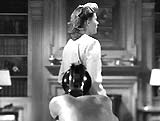 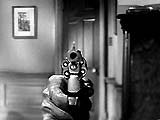  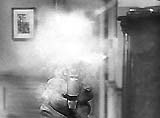 Murder Weapon Pointed at Dr. Constance Petersen (Ingrid Bergman), Then Used For Murchison's Own Suicide |
||||||||||||

|
Spider (2002)
David Cronenberg's disturbing, minimalist drama opened with a train's arrival, bearing the last passenger to disembark:
After being discharged from an asylum after 20 years, he had arrived in his boyhood town (the drab East End outskirts of London) where he was admitted into a half-way flophouse run by tyrannical Mrs. Wilkinson (Lynn Redgrave). It was located in an industrial area, next to a canal across from an imposing gas tank (foreshadowing later events). The quiet, furtive, delusional and schizophrenic individual carried a suitcase full of junk. He was often mumbling to himself, distrustful of everyone, kept illegible scribblings (hieroglyphics) in a small grimy notepad hidden under his rug, had nicotine-stained fingers from his own rolled cigarettes, unkempt hair and he wore many layers of clothing. He kept his belongings in a sock stuffed down the front of his pants. The film was named Spider due to Cleg's creation of a ceiling 'spider-web' made of discarded string in his solitary and dingy room. Other patterns of splintering spider's webs were found in Cleg's boyhood room and the cat's cradle string he played with, in the dayroom's winged bird puzzle, and in a broken sheet of glass at the asylum where Cleg had been committed. Gradually, it became clear through time shifts that he was experiencing participatory flashbacks to his 1950s horrific boyhood and past as a pale, pathetic, reticent and frightened child (played by Bradley Hall). [However, the time shifts were totally unreliable and convoluted memories.] He watched his own psychological torment and abuse, as he relived earlier traumatic events suffered at the hands of his brutish, working man plumber father Bill (Gabriel Byrne), married to a maternal, protective Mrs. Cleg (Miranda Richardson). It was a tense relationship, since Cleg spent most of his time drinking and whore-mongering at the local pub, the Dog & Beggar. One of the aggressive, slatternly, and brassy tarts in the pub, cackling, fleshy bleached-blonde Yvonne (also Miranda Richardson) with bad teeth, enticed Bill to her residence to fix her "pipes" - and soon they had messy masturbatory sex under a tunnel. She had flashed her breast at young Cleg in the pub, causing him distress. Young 'Spider' witnessed their cavortings, and then older 'Spider' watched as his mother was violently murdered by her husband (with a shovel blow to the head) when she saw him having lap sex with trampish Yvonne in a garden shed. Her bloody, wrapped body was buried in the nearby garden. In Spider's young mind, Yvonne took over for his mother - and by film's end, everything redoubled back upon itself. Spider attempted to purposefully gas his father and/or slutty step-mother with an elaborate set of strings to open the stove's gas valve, and it appeared that he accidentally murdered his loving mother. The older Spider entered Yvonne's (or Mrs. Wilkinson's) bedroom (while she was sleeping) - with a hammer and screwdriver to harm her. He was again driven away to be incarcerated, as he had been when he was younger. |
 Admitted to Halfway House by Mrs. Wilkinson (Lynn Redgrave)  Mr. Dennis Cleg (Ralph Fiennes) 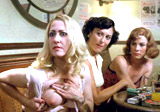 Yvonne (Miranda Richardson) at Pub 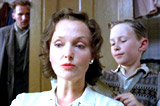 Cleg's (Spider's) Boyhood 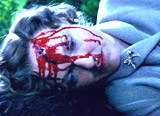 Murder of Mrs. Cleg 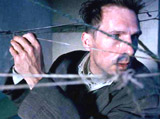 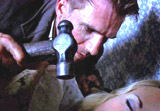 Cleg With Hammer 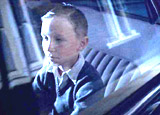
"Spider" Driven Away to be Incarcerated |
||||||||||||
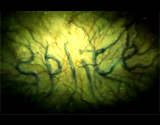
|
Splice (2010, Can./Fr./US)
This was a very unusual and erotic sci-fi thriller from director Vincenzo Natali. It was similar to various David Cronenberg films, David Lynch's Eraserhead, and the Alien and Species films. The film was a hybrid of its own, mixing a semi-serious examination of the ethical and moral dimensions of genetic experimentation with a bloody B-grade horror film (in its final 15 minutes). It featured a young and rebellious, romantically-linked scientist couple: [Note: Their names paid homage to actor Colin Clive and Elsa Lanchester in the classic horror film Bride of Frankenstein (1935).]
The two were conducting genetic engineering experiments for their gene-splicing company, N.E.R.D. (Nucleic Exchange Research + Development), run by Bill Barlow (David Hewlett). Because of their success in creating two wormlike creatures (Fred and Ginger) to help provide cures for livestock diseases, the hipster duo were further funded by corporate giant Newstead Pharmaceuticals, Inc., run by Joan Chorot (Simona Maicanescu). During this time when forbidden to push ethical boundaries, they neglected their medicinal protein synthesis work and began to conduct a secret, sophisticated genetic cloning 'experiment' in which they spliced together human and animal DNA, creating a hybrid creature. Their experimental creature first resembled a hopping, skinned rabbit-like two-legged creature with a tail (named H-50). During accelerated growth into a preadolescent humanoid female (Abigail Chu) with amphibious lungs, the life-form was continually mothered and protected by the maternal Elsa. It was dressed up in a homespun blue dress, and parented like a pet or child (although Clive strongly desired to destroy it). Elsa named it DREN ("NERD" spelled backwards), the name of the couple's company. It evolved rapidly into a bald, partly-human mutant adult female (Delphine Chaneac) - a fantastical creature with striking slanted eyes, pointed tongue, a toxic tail-stinger, and bird-like, multi-hinged legs. With her maternal instincts enlivened, Elsa seduced Clive on their couch one evening (with DREN observing from afar), and declined to have him use a condom (she remarked: "What's the worst that could happen?"). As the film progressed, the uncontrollable, 'monstrous', and troublesome female DREN was hidden at Elsa's childhood farmhouse home, where she became carnivorous, exhibited retractable wings (CGI), and killed their cat given to her as a pet. It was also revealed that Elsa had used samples of her own DNA to create DREN, causing Clive to realize that she had a "f--ked up" family history. When DREN became more troublesome and unstable, Elsa reverted to scientifically studying the creature, and bound DREN on a table. She stripped DREN of her 'human' elements, including clothing, and surgically removed her tail-stinger. Clive was attracted to the infatuated DREN, and had unconventional sex with the creature (with hints of incest and bestiality) when she wrapped her winged-arms around him, naked - and he possibly impregnated her. During intercourse, she orgasmically expanded her wings and regenerated her stinger - just as Elsa arrived and caught them in the act. After sex, the female creature appeared to die and was then buried, but regenerated into a male and became extremely violent (foreshadowed earlier in the film in the company shareholder's scene in which the two original hybrids, Fred and Ginger, both became hostile males and bloodily killed each other). At the farmhouse, the male DREN swooped down and killed both their boss Barlow and Clive's brother Gavin (Brandon McGibbon), raped Elsa (the creature demanded: "Inside you"), and when Clive attempted to rescue her by stabbing the creature in the back, he was stung to death in the heart with DREN's stinger, although Elsa was able to crush the creature's head with a rock and kill it. In the final scene, Elsa was in the office of pharmaceuticals company head, learning that DREN's synthesized proteins and corpse ("a cauldron of unimaginable chemical mysteries") would save the company from bankruptcy ("We'll be filing patents for years"). Elsa would be paid well to lead the profitable company to "the next stage" if she kept silent forever about DREN. Elsa was also pregnant, repeating the line: "What's the worst that could happen?" when asked if she wanted to walk away. The question remained: was her future offspring fathered by the male DREN or Clive? |
 Splicing Experiments 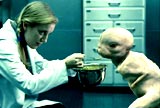 Young Humanoid Female (Abigail Chu) 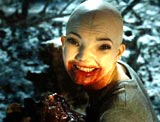 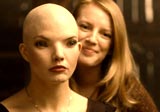 Mutant Adult Female (Delphine Chaneac)  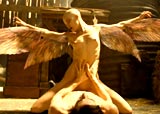 Sex Between Clive and DREN 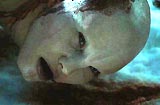 Violent Regenerated Male Version of DREN  Pregnant Elsa (Sarah Polley) |
||||||||||||

|
Stardust Memories (1980)
Writer/director Woody Allen's self-indulgent, self-referential, often incoherent, impressionistic and dark semi-autobiographical comedy has been viewed as a tribute to Fellini's 8 1/2 (1963, It.), with references to Bergman's Wild Strawberries (1957) as well. In its ending, the twist/plot device was revealed - the entire movie was a 'film-within-a-film.' However, the film was not straightforward - it was filled with non-linear flashbacks, flash-forwards and fantasies. Pretentious and self-absorbed comedic film-maker/director Sandy Bates (or Woody Allen?), suffering from writer's block, was invited to a retrospective film festival/charity event of his own work, at the Stardust Hotel beach resort in New Jersey for the weekend. During the gathering of often annoying and time-consuming fans, groupies, scriptwriters, studio executives, friends, and autograph-seekers, Bates also struggled with his own career, his celebrity status, personal demons, aspirations, daydreams, and expectations. He complained about various diseases, human suffering, impotence, catastrophes, and his own bad luck. The film being screened was actually an accounting of Sandy's love of a tangled trio of women (all of his partners were actresses in his film that was being screened):
In the film's conclusion, Sandy recalled one of his happiest moments with Dorrie, the simple pleasure on a Sunday when she was reading the newspaper on his floor and he looked over at her:
The respected director had been praised for his earlier comedies, but now with this film ending, he feared being criticized for wanting to make films with more serious content (and without happy endings). Audience members, viewing the 'film-within-a-film', yelled out that his earlier films were funnier:
Suddenly, Sandy fainted from "nervous tension," after an hallucination of being shot by a fan with a .32 caliber pistol. Isobel tended to him, then ran out when he kept calling out: "Dorrie!" Rushing outside after her, he was accosted by police who jailed him for having a .32 pistol in his car without a permit. During his incarceration, he was seen chasing after Isobel who had boarded a train compartment and was vowing to leave him. He begged her to stay with him, by claiming that he had thought of a new and better ending for his film - the film being watched - about being on a train with Isobel and having a "good sentimental" relationship with her. She thought otherwise: "You like those dark women with all their problems...They give you a hard time and you like." Eventually, he convinced her to give him "a huge, big wet kiss" - it "would go a long way to selling this idea." He then added: "I'm very serious. I think this is a big, big finish, you know?" The train pulled out of the station as they hugged and kissed - and the audience clapped its approval of the film's coda. Members of the audience commenting on the screened film afterwards included all three of the women in Sandy's life. |
 Sandy Bates (Woody Allen)  Dorrie (Charlotte Rampling) 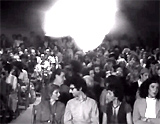 The Screening: "Cop-out Artist!"  Isobel (Marie-Christine Barrault) 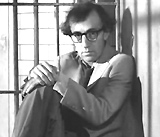 Sandy In Jail  The "Huge, Big Wet Kiss" That Ended The Film 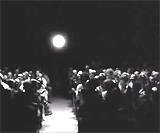 The Screening Ends: The Applauding Film Audience 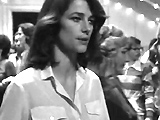 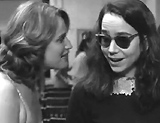 Audience Members: The Three Women in Sandy's Life |
||||||||||||

|
Starship Troopers (1997)
Paul Verhoeven's military-related adventure-action film was a combination spoof of militarism, and a violent science-fiction saga set in the 23rd century. It told about a group of fresh-faced, gung-ho college graduates who enlisted and trained in the futuristic Federal Service (military) based on Earth, but with technology were allowed to explore other regions of the universe, including Klendathu. It was the homeworld of giant, intelligent, lethal pseudo-arachnid enemy of insect-inhabitants called "Bugs". At the end, the entire film was revealed to be the broadcast of a propaganda film (a movie within a movie) to recruit young men and women to sign up for military service. The film ended with a commercial to "JOIN Up Now!" - a recruitment ad by a futuristic totalitarian military government in a 'fascist utopia.' The Federal Network's narrator/announcer spoke (in voice-over):
The ending also posed the question about the identity of the aggressor - it was strongly suggested that the humans were the would-be world-conquering invaders! |
   Recruitment Ad For the Military |
||||||||||||

|
Star Trek: The Motion Picture (1979)
The film opened in the year 2271 with a massive bluish cloud, a vast energy-power field of some kind (an "alien object of unbelievable destructive power"), that threatened and destroyed three alien Klingon warships and the Starfleet's monitoring com station Epsilon 9. It was poised to destroy Earth itself ("the third planet of the solar system"), and revealed to have a "highly advanced mentality" that consisted of "a form of plasma energy." The powerful force was mysteriously named V'Ger, and its cryptic objective was:
Spock (Leonard Nimoy) surmised during an unauthorized jet-pack 'space-walk' that the USS Enterprise had been taken "inside a living machine...a conscious living entity." Spock described how V'Ger was lonely and "has knowledge that spans this universe and yet with all its pure logic, V'Ger is barren, cold. No mystery. No beauty." V'Ger appeared to be asking questions, such as: "Is this all that I am? Is there nothing more?" V'Ger was attempting to communicate with its creator (a machine), using a simple radio wave, but the creator was not answering. Spock explained: "V'Ger is a child...evolving, learning, searching, instinctively needing...It knows only that it needs, Commander. But like so many of us, it does not know what." The "object at the heart of that cloud" in an inner "brain" chamber - "part of the vessel's inner mechanism" - was a transmitter ("a vital link between V'Ger and its creator"). The crew discovered that V'Ger (or Voyager) was formerly the unmanned scientific space probe and data-collecting transmitter Voyager 6 that was launched by NASA from Earth in the 20th century (with a mounted plaque that read VOYAGER VI) more than 300 years earlier. After disappearing into a black hole, it crash-landed on a planet inhabited by an alien race of living machines, was rebuilt with a new surrounding vessel (the cloud) to house V'Ger, and reprogrammed to continue collecting data and returning that information to its creator NASA on Earth - "on its journey back, it amassed so much knowledge, it achieved consciousness itself. It became a living thing." To have it completely fulfill its transmission, however, V'Ger insisted that it be joined with its creator to allow V'Ger to fully evolve. Commander Willard Decker (Stephen Collins) sacrificially offered himself up to physically merge with V'Ger (symbolized by uniting with its android probe Ilia (Persis Khambatta) - the two were former human lovers) to provide a "human quality" - to merge human and machine. The merging took place in a dazzling, explosive shower of white light, creating a new glowing alien entity or non-corporeal life form ("We witnessed a birth. Possibly a next step in our evolution") from which the USS Enterprise emerged - unscathed for its next mission. |
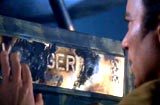 V'Ger (formerly the Voyager Unmanned Spacecraft) 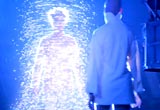   Commander Willard Decker (Stephen Collins) Merging With V'Ger (represented by Ilia (Persis Khambatta)) |
||||||||||||